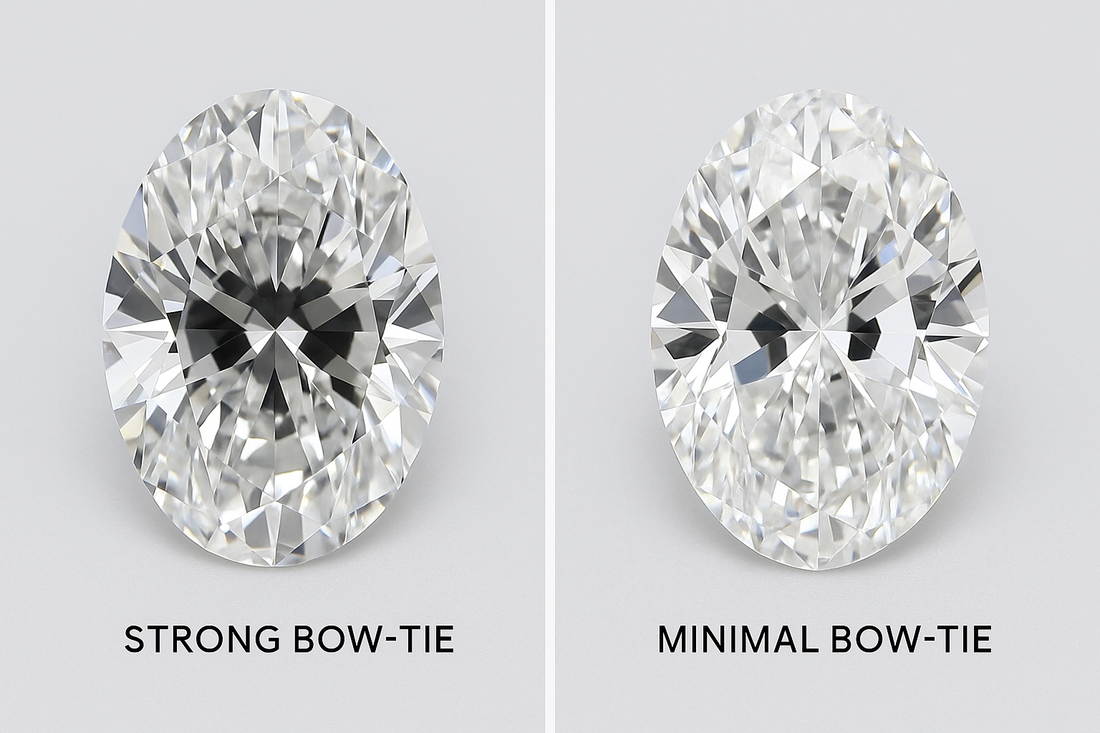
The Bow-Tie Effect in Diamonds: What It Is, Why It Happens, and How to Minimize It
Share
When it comes to fancy-shaped diamonds, there’s one optical quirk that jewelers and buyers alike keep an eye out for: the bow-tie effect.
Named for its resemblance to a dark bow-tie stretching across the center of the stone, this phenomenon can impact how much brilliance a diamond displays. And while a subtle bow-tie can add depth and character, an overly dark one can detract from the sparkle you expect in a fine diamond.
Here’s everything you need to know about the bow-tie effect—why it happens, which cuts are most prone to it, and how to shop smart to minimize its appearance.
What Is the Bow-Tie Effect?
The bow-tie effect appears as a shadowy, bow-shaped pattern across the center of a diamond. Instead of light bouncing back through the stone, part of it is blocked or lost, creating the illusion of a dark patch.
This isn’t a flaw in the diamond itself—it’s the result of the way light interacts with the stone’s proportions and facet alignment.
Which Diamond Shapes Show It Most?
The bow-tie effect is most commonly seen in elongated fancy shapes, especially those with pointed ends:
-
Oval Cut Diamonds
Beautiful and flattering on the hand, but often reveal a bow-tie if not cut with precision. -
Marquise Cut Diamonds
Their stretched shape makes them especially vulnerable to light leakage in the center. -
Pear Cut Diamonds
The tapered end adds elegance, but improper angles can create a noticeable bow-tie. -
Elongated Cushion and Radiant Cuts
Though less prone, certain cutting proportions can still result in a muted bow-tie shadow.
Round brilliant diamonds rarely show a bow-tie, as their facet structure maximizes light return in all directions.
Why Does It Happen?
At its core, the bow-tie effect is a matter of geometry. If the diamond’s pavilion (the lower half of the stone) and crown angles don’t align perfectly, light won’t reflect back evenly. Instead, some of it escapes, and your eye perceives that loss of light as a shadow.
-
Shallow or overly deep cuts → Lead to uneven light distribution.
-
Facet misalignment → Creates light leakage zones in the stone’s center.
-
Proportions outside optimal ranges → Especially in elongated cuts, where depth and length must balance carefully.
Is a Bow-Tie Always Bad?
Not necessarily. A very faint bow-tie can actually enhance a diamond’s character, adding contrast and dimension to its sparkle. The issue arises when the bow-tie is too dark, wide, or obvious—distracting from the brilliance of the stone.
How to Minimize the Bow-Tie Effect
-
Examine in Multiple Lighting Conditions
Natural daylight, spotlights, and soft indoor light will all reveal different aspects of a stone. Always view diamonds in more than one setting. -
Look for Balance, Not Elimination
Almost all oval, pear, and marquise diamonds will have some bow-tie. The goal is to find one where it appears subtle and doesn’t overpower the sparkle. -
Check Depth and Proportions
For fancy shapes, depth percentages that are too shallow or too deep often exaggerate the bow-tie. Work with jewelers who provide detailed cut data. -
Rotate the Stone
Move the diamond as you view it. A well-cut stone will sparkle brightly from most angles, keeping the bow-tie less noticeable.
Final Thoughts
The bow-tie effect is a natural quirk of certain diamond shapes—but it doesn’t have to define the stone. With the right cut, proportions, and a careful eye, you can find an oval, pear, or marquise diamond that radiates brilliance, depth, and elegance without compromise.
Because a diamond should reflect light, yes—but it should also reflect your story.
Written by Mia Laurent
Content Editor, Altura Diamond Blog
